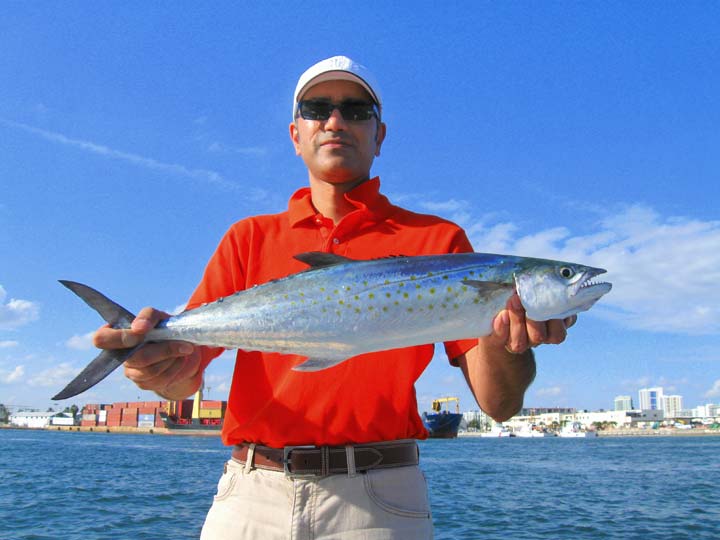Email Me:CaptMo@netzero.com | Tel:(786)853-1409 | BOOK A CHARTER
HOME CONTACT ABOUT CAPT. MO GALLERY BOOK A CHARTER MO'S FISHING REPORT TESTIMONIALS ABOUT BISCAYNE BAYABOUT CHARTERSLINKS
Permit
The Mackerel
Late fall and winter are great times of year to target mackerel.
These fish are fast, aggressive, strong and eat most anything thrown at them making it a great target for clients that want to catch dozens of them and have an absolute great time. I typically target these fish with light 8lb gear and fly rods. Baits such as live pilchards work great but I prefer to use artificial for them as the rate at which these fish are caught makes it more productive. It is not unusual for clients to catch over 30 mackerel in a span of an hour or less and singing drags is always part of the outcome of a lure tossed into the school.
Spanish Mackerel: Scomberomorous maculatus
Appearance:
- Color of back green, shading to silver on sides with golden yellow irregular spots found above and below the lateral line
- Front of dorsal fin is black
- Lateral line curves gently to base of tail
Habitat:
Spanish mackerel are prevalent throughout Florida waters: inshore, offshore and nearshore. They are frequently found over grass beds and reefs. These mackerel are absent from north Florida waters in winter.
Behavior:
Spanish mackerel are a schooling fish that migrates northward in spring, returning to southerly waters when water temperature drops below 70 degrees F. They spawns offshore from spring through summer and feeds on small fish and squid.
State Record:
12 lb, caught near Ft. Pierce
Additional Information:
Spanish mackerel are similar in appearance to cero, S. regalis; and king mackerel, S. cavalla.
Cero Mackerel: Scomberomorous regalisAppearance:
- Color of back iridescent bluish green
- Sides silvery with yellow spots forming lines above and below a bronze stripe from pectoral fin to base of tail
- Front of the first dorsal fin is bluish black
- Lateral line curves gradually to base of caudal fin
Habitat:
Cero mackerel are nearshore and offshore fish occurring mainly in south Florida. The are frequently found over coral reefs and wrecks.
Behavior:
Unlike other mackerels, cero mackerels do not stray far from south Florida waters. They spawn offhshore in midsummer and feed on small fish and squid.
State Record:
17 lb 2 oz, caught near Islamorada
Fishing Tips & Facts:
Similar Fish: Spanish mackerel, S. maculatus; king mackerel, S. cavalla (only the cero has the yellow-brown stripes from the pectoral to caudal fin).
Scroll through the pics to the right to see some of Captain Mo's latest adventures:
It could be you posing with one of those beauties!
Book a charter today. All ages and skill levels welcome.
(786)853-1409.
Home | Contact | About Capt. Mo | Gallery
Mo's Fishing Report | Testimonials | About Biscayne Bay | About Charters | Links



